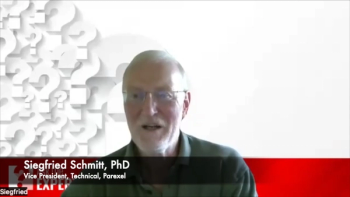
- BioPharm International-12-01-2006
- Volume 19
- Issue 12
Regulatory Beat: Campaign Heats Up for Follow-On Biologics
The prospect of any cost savings has been fueling efforts to establish a pathway for follow-on biopharmaceuticals.
The development of more high-cost biotech therapies with steep price tags is spurring demand for a legal pathway to bring competitive treatments to market. Federal and state officials, insurers, and pharmacy benefit managers are clamoring for generic versions of biopharmaceuticals as a safe way to improve patient care while controlling expenditures. Consumers support such action as a way to cope with higher copays for brand-name drugs.
Jill Wechsler
Although the Food and Drug Administration (FDA) has been slow to articulate a regulatory pathway for follow-on protein products (FDA's preferred term), several developments are moving the debate forward. A federal court compelled the agency to act on an application for a follow-on biologic earlier this year. And that action prompted members of Congress to introduce legislation laying out a possible regulatory approach. All signs point to extended debate on the issue in the coming year, particularly with Democrats gaining control of Congress.
MANUFACTURING ISSUES KEY
While economic forces drive the clamor for generic versions of biologics and other drug dosage forms, more efficient and technically advanced analytical and production systems are key to producing follow-on versions of complex drugs. Demonstrating comparability of large molecules requires an understanding of molecular structure, heterogeneity profile, impurities, and degradation patterns. Manufacturing systems have to be high quality and well-controlled. Because production of therapies from living cell cultures can be variable, even politicians recognize that it may not be possible to develop identical or therapeutically equivalent biotech generics. Nevertheless, the prospect of any cost savings has been fueling efforts to establish a pathway for follow-on biopharmaceuticals once patents expire.
FDA has held meetings on the scientific and technical issues related to developing follow-on protein products, but the political infighting has delayed a long-promised white paper on the relevant regulatory issues. A key point of contention is whether generic firms would have to conduct a full battery of clinical trials to document that a follow-on product has a similar efficacy and immunogenicity profile as a reference product. Biotech and pharma companies insist that another manufacturer cannot access proprietary clinical or manufacturing data on biologics and that new legislation is needed to clarify FDA's regulatory authority in this area.
The Hatch-Waxman Act of 1984 established a legal process for developing generic versions of conventional drugs regulated by the Food, Drug and Cosmetic Act, but does not apply to proteins and other biologics that fall under the Public Health Service Act. While new legislation is needed to address the issue, generic drug advocates believe that Hatch-Waxman should cover those few biologics that are regulated as drugs, such as insulin and human growth hormone. FDA has drafted guidances for developing generic versions of these products, but said in April 2006 it was holding off on product-specific guidances for biogenerics, in order to draft an approval requirement for all follow-on biologics.
ACTION ON OMNITROPE
While everyone is waiting for such guidance, the agency was compelled to move forward and evaluate an application for a follow-on version of the human growth hormone Omnitrope from Sandoz, Novartis' generics unit. FDA approved the application last May, nearly three years after Sandoz filed it and only when a federal court ruled that the agency had to stop stalling and act .
Sandoz opted for the 505(b)(2) application route, which permits a manufacturer to tap publicly available data on a reference product instead of duplicating all preclinical and clinical studies. In approving the application, FDA noted that it did so because Omnitrope is a well-characterized product with a well-known primary structure and mechanism of action and publicly available bioassays and biomarkers. FDA determined that it was sufficient for Sandoz to document safety and effectiveness of its own system for cell expression, fermentation, isolation, and purification of the active ingredient, instead of proving that Omnitrope has the same active ingredient as its reference drug (Pfizer's Genotropin), as is required for conventional abbre- viated new drug applications.
Moreover, Sandoz conducted a number of clinical trials to demonstrate a similar safety and efficacy profile plus a low, acceptable immunogenicity level. Even though the scope and duration of these studies represents a modified clinical program, the trials avoided reliance on innovators' proprietary data. FDA thus rejected petitions opposing the approval from Pfizer, Genentech, and the Biotechnology Industry Organization (BIO).
At the same time, the agency did not rate Omnitrope as equivalent to Genotropin. FDA emphasized that the approval does not establish a pathway for other biotech products to come to market, including other proteins regulated as drugs.
PROPOSING LEGISLATION
In explaining its action on Omnitrope, FDA reiterated its request for new legislation to clarify its legal authority to approve follow-on versions of any biotech therapies. Just before Congress recessed in October, three leading Democratic legislators offered a proposal to move the debate forward. Rep. Henry Waxman of California and Sens. Charles Schumer and Hillary Rodham Clinton of New York introduced the "Access to Life-Saving Medicine Act" (HR 6257) that describes an approach for approving copies of biopharmaceuticals. Although the legislators acknowledge that more complicated scientific issues are involved in demonstrating that a generic version of a biotech drug is the same as the branded product, they assert that the Omnitrope approval shows that this approach is "scientifically feasible."
The bill authorizes FDA to approve abbreviated applications for biological products that are "comparable" to previously approved biologics. FDA will determine on a case-by-case basis what clinical and preclinical studies are necessary to establish comparability, and all applications for follow-on biologics would pay user fees.
A summary of the bill points to the importance of documenting comparability with extensive technical and scientific knowledge. A comparable product has to share the "principal molecular structural features" and have the same mechanism of action (if known), route of administration, dosage form and strength. Manufacturing controls must assure product identity, strength, quality, and purity.
The legislation also encourages manufacturers to conduct additional testing to demonstrate that a product is interchangeable with the reference product, instead of just comparable. Interchangeable products would produce the "same clinical result(s)" as a reference product. Because clinical testing would be required, the bill offers manufacturers tax credits to cover the extra studies, plus six months exclusivity for the first applicant that establishes interchangeability.
The bill aims to prevent innovator firms from maneuvering to extend patents and block new follow-on products from market; there will be no authorized generics by brand firms during the exclusivity period and curbs on frivolous citizens petitions. The measure also seeks to resolve patent disputes early on by establishing a new patent listing and notification procedure.
Because follow-on biologics would be more difficult and time-consuming for FDA to assess and approve, the bill boosts FDA resources by establishing user fees for follow-on biologics applications, a move that may set a precedent for the generic drug industry overall. Generic drug manufacturers are the only drug industry segment that do not have to ante up to file applications or support FDA oversight of marketed products. The issue has been discussed for years, and the current squeeze on FDA resources puts these issues on the table for negotiation as part of the debate on the renewal of the Prescription Drug User Fee program (PDUFA) in the coming year.
Jill Wechsler is BioPharm International's Washington editor, 7715 Rocton Avenue, Chevy Chase, MD 20815, 301.656.4634,
Articles in this issue
almost 19 years ago
Outsourcing: Offshoring to China: What Should Your Model Be?almost 19 years ago
Street Talk: Stem Cells: Tough Sell on Wall Street?almost 19 years ago
From the Editor: The Stem Cell Votealmost 19 years ago
Final Word: New Organization Forms to Help FDA Fulfill its MissionNewsletter
Stay at the forefront of biopharmaceutical innovation—subscribe to BioPharm International for expert insights on drug development, manufacturing, compliance, and more.





